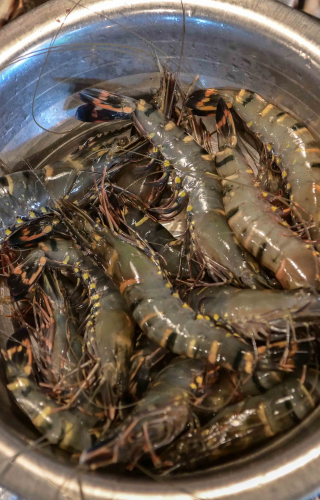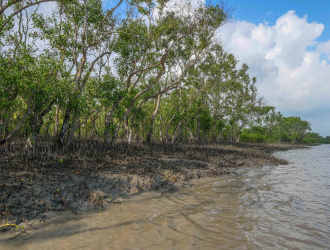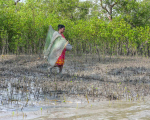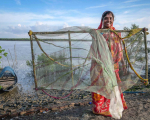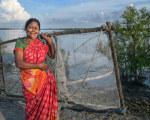Sundarbans is a mangrove forest on the delta of the Ganges, Brahmaputra and Meghna rivers on the Bay of Bengal. The islands stretch across India and Bangladesh, a shared UNESCO Natural World Heritage Site. For all its beauty, the Sundarbans is a delicate ecosystem; it is a complex network of tidal waterways, mudflats and small islands of salt-tolerant mangrove forests. The landscape is constantly shifting and changing, and climate change with rising sea levels have added to coastline erosion. Due to the unstable terrain and extreme weather, livelihood opportunities are limited in the Sundarbans. People are primarily dependent on agriculture but face soil damage because of the saline seawater which often floods the fields. Outside agriculture, people depend on forest produce, fishing or foraging.
On my recent trip to the Sundarbans, while strolling on a river dyke of Gosaba Block, I saw an old woman staring at the river. I walked up to her to start a conversation. In a muffled voice, Giribala Mondol replied, "2020 is turning out to be a very bad year for us. I don’t know what to do. Cyclone Amphan destroyed all the crops, fish ponds and our homes, and then came the lockdown. There is hardly any buyer for our meen, my only source of earning. Now I am struggling to make ends meet."
Curious, I ask Giribala to enlighten me on meen. She explained, "The tiger shrimp (Penaeus monodon)—what Bengalis call Bagda Chingri—seedling is known as meen, and people who trap meen are known as meendhara." This shrimp, though harvested in a brine pond, do not reproduce in a controlled environment. They lay their eggs in the wild, which must be harvested manually. Bagda chingri is not the only shrimp farmed here. A larger variety (Golda Chingri), the giant river prawn (Macrobrachium rosenbergii) is also harvested. Another variety is the whiteleg shrimp (Litopenaeus vannamei), which is replacing the badga chingri due to its cost effective farming and less susceptibility to disease. Another variety, the Indian shrimp (Fenneropenaeus indicus), has relatively lower market value than the rest.
A fertile meen looks like a thin brown thread, less than an inch long. It is very difficult to detect in muddy water amongst debris and dirt. "For 40 years, my eyes have been trained to find meen in murky water," Giribala stated proudly. This is an exclusively women-led activity. Men, who are also engaged in fishing, venture with trawlers in the deep sea or go inside dense forests to collect honey and catch wild crabs. In poor households, even children assist their mothers in this job. I walked with Giribala and her friends to their village where many fisherwomen joined me over a cup of tea and explained the process.
"Meen catching is a labour intensive job," stated Protima Mondal. "To catch meen we make a special net." They enthusiastically showed me a net, which is basically a rectangular frame made of bamboo, with a fine net tied around the frame. At the base of the net, a long pouch is attached. The frame is dragged over water using strings attached to it. When the net is lifted, the catch gets deposited in the pouch bag. The contents of the pouch are then emptied in a cooking vessel. A shiny white sea-shell is used to detect the meen. "It is very stressful on our eyes, particularly in night," stated Bhabani Khatua.
Although they catch meen throughout the year, peak season is usually April and May. The best time to catch meen is during low tide, when the river bed is exposed. The timing of tides changes every day. A typical low tide lasts for three to four hours. Low tides can also happen during evening, late night or early morning. So, the time of meen collection changes with the timing of the low tide. Two meendharas explained this to me, and asked me to join them the next day to watch them in action.
Next day I arrived at the rendezvous point and scanned the beautiful mangroves while waiting for the meendharas to arrive. The ecosystem of the mangroves not only reduce erosion from storm surges, currents, waves and tides, but its submerged roots provides a perfect hiding space for marine species, a breeding ground for the tiger prawn. I noticed they were all barefoot. It is not an easy task to walk on mangroves barefoot, but there is no option because it is impossible to walk wearing footwear. The river bank is littered with sharp mangrove roots, bones, shells and other sharp objects, so cuts and bruises are common. In addition, meendharas wade in waist/chest deep saline water for three– four hours; this leads to itches and skin-related problems, including vaginal infections. Moreover, the waters are infested with snakes and crocodiles. Every time they are in open water, they put their life at risk. To avoid getting dragged away in the current or a tiger, they venture in a group and stick close to each other, keeping an eye for signs of danger.
The practice of trapping meen started in the 80s, when shrimp farming emerged as a lucrative business. A good catch ranges between 300–500 seedlings within three–four hours of fishing. Even 10–20 years ago, a good catch netter more than 1000 meens. Today a single meen fetches 10–20 paisa only. "A good week fetches 600–700 Rupees," remarked Dipa Gayen. Agents visit the villages to purchase the meen, and meenddharas are paid a fixed rate. The agents sell to tiger prawn farmers. A kilogram of adult tiger prawn has 10–12 tiger prawns and costs approximately INR 400–500, depending on the size of the prawns, but prices can go above INR 1,000 for high-quality shrimps. From this, the fisherwoman receives only a rupee for catching 10 live meen.
Nowadays meen catch has reduced due to various human-induced and natural reasons. The cover area of mangroves has shrunk, resulting in loss of breeding environment. Mechanised trawlers haul in large catches of prawn that enters the delta to lay eggs, leaving little chance for them to reproduce. Chemical pollution, through release of oil/grease from boats and human waste from villages, has changed water quality. Due to human activities in the fringe areas, marine fauna is changing breeding behaviour and shifting to core areas of the jungle, which are still inaccessible. In addition, tropical cyclones have frequently hit this region, resulting in a decline in meen catch. Again, tiger prawn farming is very sensitive and prone to diseases, so fisheries are shifting to Vannamei shrimp farming. This particular variety of shrimp has low maintenance and is commercially profitable.
According to environmentalists, meendharas trampling through mangroves is partly responsible for decline in meen. This makes the soil loose and subsequently erodes the coastline. To counter cyclone damage, the government and NGOs are pushing for plantation of mangroves along the river beds, but the trampling of the soil damages growth of new mangroves. Another harmful practice is wasteful dragging. The drag nets catch all kinds of marine life apart from meen, including some endangered fish species and their eggs. During segregation, meendharas throw away the unwanted catch, resulting in premature death of species at the spawning stage.
By the time the women assembled to return to their villages, it was late evening. Kajoli Mondol offered to walk me back to my lodging. Kajoli, now in her late 50s, explained to me that for the last 30 years meen catching has supported her in critical moments. This livelihood has helped her educate her children. Even with the abysmal low returns, it still is a lifeline for many women in the Sundarbans. Bidding Kajoli farewell, I contemplated on the contradiction of the local population’s economic struggle in the natural richness of the Sundarbans—a world so abundant, yet so unforgiving.
This photo-essay has been created as part of the Sahapedia Frames Photography Grant, supported by CSR funding from IndusInd Bank.
